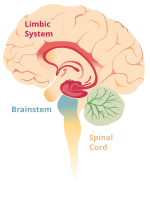Motivation and emotion/Tutorials/Needs
Tutorial 02: Needs
This is the second tutorial for the motivation and emotion unit of study.
This tutorial is complete for 2019. |
Overview[edit | edit source]
This tutorial:
- introduces brain structures which are relevant to motivation and emotion
- discusses the motivational and emotional role of neurotransmitters and hormones
- considers psychological needs, with a particular focus on Deci and Ryan's taxonomy of motivation and self-determination theory
- discusses book chapter topic development
Physiological aspects of motivation and emotion[edit | edit source]
Important physiological elements of our motivational and emotional experiences include brain structures, neurotransmitters, and hormones. Whilst each of these components serves particular functions, they also communicate directly or indirectly with one another to work dynamically and holistically.
Brain structures and functions[edit | edit source]
The purpose of this section is to become familiar with brain structures which have important motivational and emotional functions.
Triune brain theory[edit | edit source]
A useful starting point to understanding the human brain structures which relate to our motivational and emotional lives, is the triune theory which understands the brain as having evolved in evolutionary layers:
- Reptilian brain (Brain stem): Instinct, survival, alertness
- Mammalian brain (Limbic system / Mid-brain): Emotional functions
- Human brain (Neocortex): Higher order capacities to self-regulate, plan, make choices, exercise volition, decide whether to approach or avoid, and so on, in the frontal cortex.

Brain structures[edit | edit source]

Activity: Mix and match activity in small groups
- Face-to-face
- Review the master list of brain structures and functions.
- Cut up the copy into separate structures and functions, then mix them around.
- As a group, match the brain structures to their functions - do the best you can, then check against the master list.
- Mix them up, and try again - repeat process until your group can get them all right.
- Online
- Use this link:
Brain structure mix and match activity - Each person should allocate themselves to researching a structure; once completed, add your name to a free structure until complete
- 3D Brain structure app
This is a recommended app to install and explore the location and function of important brain structures:
|
Hormones and neurotransmitters[edit | edit source]
- Ask/discuss:
- What is a hormone?
- What is a neurotransmitter?
Hormones[edit | edit source]
See also: Catecholamine |
- Face-to-face activity
- Allocate each person a hormone or a function of a hormone - from this list.
- Invite class to 'find their match' and discuss what they know about how this physiological element works. (If someone is really lost, encouraged others to help them out; last resort - give them a hint)
- Ask the pairs to explain their match to the class and what else they know about that hormone; encourage other's input
- Optional: Mix-up and repeat again.
- Online activity
- Go to the mix and match spreadsheet:
Hormones, neurotransmitters and their motivational and emotional function - Mix and match - Allocate your name to one of the hormones research the correct answer. Once finished, select any that are free until the task is complete.
Neurotransmitters[edit | edit source]
|
- Face-to-face activity
- Allocate each person a neurotransmitter or a function of a neurotransmitter - from this list.
- Invite class to 'find their match' and discuss what they know about how this physiological element works. (If someone is really lost, encouraged others to help them out; last resort - give them a hint)
- Ask the pairs to explain their match to the class and what else they know about that hormone; encourage other's input
- Optional: Mix-up and repeat again.
- Online activity
- Go to the mix and match spreadsheet:
Hormones, neurotransmitters and their motivational and emotional function - Mix and match - Allocate your name to one of the neurotransmitters and research the correct answer. Once finished, select any that are free until the task is complete.
Needs[edit | edit source]
Brainstorm and discuss:
- What are needs?
Discuss and define - needs are requirements for physiological and psychological health and well-being (e.g., eating (nutrients/energy), hydration, temperature, sleeping). - How do needs differ from desires, wants, likes etc.?
Needs are essential for survival and well-being; desires, wants, likes etc. are motivations for non-essential stimuli (e.g., An umbrella in the rain) - What types of needs are there?
Brainstorm. Reeve (2018) classifies needs as physiological, psychological and implicit (social). - Deficit vs. growth needs
Intrinsic and extrinsic motivation[edit | edit source]
- The intrinsic-extrinsic motivational distinction is widely recognised and accepted. However, it risks being overly simplistic. Discuss:
- What is intrinsic motivation (IM)?
- What is extrinsic motivation (EM)?
- What are some advantages of conceptualising motivation in this way?
(e.g., simple, easy to understand and helps with research designs) - What are some disadvantages of conceptualisating motivation in this way?
(e.g., motivational sources are often complex and dynamic, involving aspects of both intrinsic and extrinsic motivation) - Deci and Ryan (2000)'s taxonomy of motivation (Figure 1) describes a motivational spectrum including amotivation, four types of extrinsic motivation, and intrinsic motivation.
- What are each of the types motivation described by Deci and Ryan's taxonomy? Handout a blanked version of Deci and Ryan's taxonomy and facilitate the class to define, discuss, and generate examples for each of the components:
- Amotivation
- Extrinsic motivation
- External regulation
- Introjection
- Identification
- Integration
- Intrinsic motivation
Psychological needs[edit | edit source]
- Self Determination Theory
- Provide an overview of Self-Determination Theory (SDT):
- Who has heard of it?
- What they know about it?
- What is the theory for?
- Who is it by?
- What are the key components?
- Autonomy
- Competence
- Relatedness
- Quiz the class a bit further about what it knows about "autonomy" and what might be meant by "autonomy support"?
- Watch the 14 min. video, Promoting motivation, health, and excellence (Ed Deci, TEDx) (youtube) and note answers to:
- What is autonomy-based motivation?
- Why does autonomy-based motivation matter?
- How can we facilitate autonomy-based motivation? (e.g., as leaders, managers, teachers, parents)
Book chapter development[edit | edit source]
Topic development[edit | edit source]
- Conduct a quick poll of who has:
- Who doesn't have a topic? (sign up or propose a topic ASAP) - Discuss/help
- Who hasn't edited the chapter page they are working on yet with draft headings and dot-points? - Discuss/help
- Who has started a chapter plan? (e.g., headings, key points, key references)
- Who has made a social contribution (an edit beyond their user page or book chapter, discussion post, or tweet)?
- Who has logged a social contribution on their user page? (see making and summarising social contributions)
- Brainstorm and discuss:
- Book chapter structure - Main sections - Overview, Body headings, Conclusion, See also, References, External links
- Learning features - Basically, anything that is not paragraph text - Internal and external links, Images, Tables, Feature boxes, Quizzes
- Social contribution (any logged contribution beyond one's primary chapter)
Images[edit | edit source]
Live demo - ask for a volunteer chapter.

- Searching
- Wikimedia Commons
- Wikimedia Commons search results might include:
- A page with thumbnails for relevant images (e.g., Psychology
- A category with links to relevant sub-categories and thumbnails (e.g., Category:Emotions)
- A list of search results with thumbnails (e.g., worried
- It is also possible to search Wikimedia Commons directly through the Visual Editor, using the File name field.
- Google Images with License filtering to identify free to use images (advanced - filter - usage rights)
- Creative Commons
- Wikimedia Commons
- Embedding
- Edit a Wikiversity page and add an image using the Visual Editor, including captioning, positioning and sizing of the image (Edit - Insert - Media - File name)
- Repeat for a second image
- Uploading to Wikimedia Commons
- Upload images to Wiki Commons - how to video
Tables[edit | edit source]
- Easiest to use the visual editor
- Tables
Social contributions[edit | edit source]
- Wikiversity
- Editing other chapters - previous or current
- Thanking
- Undoing changes (via History)
- Commenting other chapters
- Watchlist (favourite pages and then click on Watchlist to see latest changes)
- Preferences e.g., email notifications
- Editing other chapters - previous or current
- UCLearn discussion forum posts
- #emot23 twitter posts
- Summarising social contributions on user page with links to evidence
Recording[edit | edit source]
- Tutorial 02 recording, 2019
- Tutorial 02 recording, 2017
See also[edit | edit source]
- Extra tutorial exercises
- Models which organise needs (Extra tutorial exercise)
- Implicit motives (Extra tutorial exercise)
- Lectures and tutorials
- Brain and physiological needs (Lecture)
- Extrinsic motivation and psychological needs (Lecture)
- Introduction (Previous tutorial)
- Goals and self (Next tutorial)
- Tutorial session notes - Instructor notes
- Book chapters
- Oxytocin and emotion (Book chapter)
External links[edit | edit source]
- BIS/BAS scales (fortrefuge.com)
- 2-Minute Neuroscience: Ventral Tegmental Area (VTA) (Youtube)